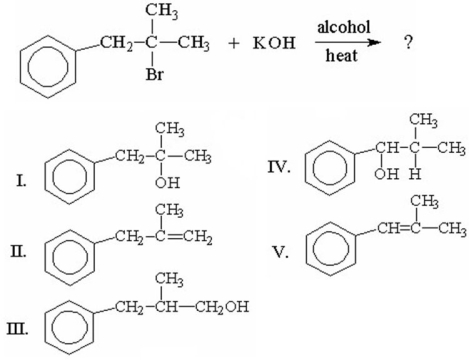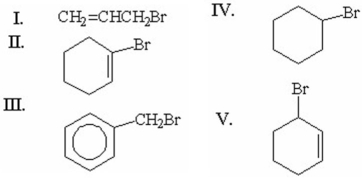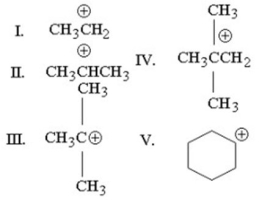A) ![]()
B) CH2 ![]() CH2
CH2
C) ![]()
D) A and B
E) A and C
Correct Answer

verified
Correct Answer
verified
Multiple Choice
What mechanism predominates in the reaction below? 
A) SN2
B) SN1 without rearrangement
C) SN1 with rearrangement
D) E2
E) E1
Correct Answer

verified
Correct Answer
verified
Multiple Choice
Assuming no other changes,what is the effect of doubling both the alkyl halide and the nucleophile concentrations in the above reaction?
A) no change
B) doubles the rate
C) triples the rate
D) quadruples the rate
E) rate is halved
Correct Answer

verified
Correct Answer
verified
Multiple Choice
What is the major product of the following reaction? 
A) I
B) II
C) III
D) IV
E) V
Correct Answer

verified
Correct Answer
verified
Multiple Choice
Give the major product for the following E1 reaction. 
A) ![]()
B) ![]()
C) ![]()
D) ![]()
E) ![]()
Correct Answer

verified
Correct Answer
verified
Multiple Choice
Which of the following can't undergo nucleophilic substitution reactions? 
A) I
B) II
C) III
D) IV
E) V
Correct Answer

verified
Correct Answer
verified
Multiple Choice
Which of the following correctly describes the relative nucleophilicities of methoxide and tert-butoxide?
A) These alkoxides have essentially the same nucleophilicities since the negative charge in both is localized on an oxygen atom.
B) Methoxide is more nucleophilic because the nucleophilicity of tert-butoxide is diminished by steric effects.
C) tert-Butoxide is more nucleophilic because it contains three methyl groups which increase the charge on its oxygen by donating electron density.
D) tert-Butoxide is more nucleophilic because it is more basic.
E) none of the above
Correct Answer

verified
Correct Answer
verified
Multiple Choice
Which of the following bases gives the highest anti-Zaitsev product in E2 reactions when reacted with 2-bromo-2,3-dimethylbutane?
A) ![]()
B) ![]()
C) ![]()
D) ![]()
E) ![]()
Correct Answer

verified
Correct Answer
verified
Multiple Choice
Give the best answer for the reaction. 
A) CH3CH2OCH3
B) CH3CH2OCH2CH3
C) CH3CH2OCH2CH2CH3
D) CH3CH2CH2OCH2CH2CH3
E) CH3CH2CH2OCH2CH2CH2CH3
Correct Answer

verified
Correct Answer
verified
Essay
When 1-bromo-2,2-dimethylcyclopentane is heated in ethanol,one of the products which results is shown below.Provide a detailed,stepwise mechanism for the production of this compound,and give the name of the mechanism by which it is produced. 
Correct Answer

verified
Correct Answer
verified
Essay
How would you obtain the following product from 1-bromo-1-methylcyclohexane? 
Correct Answer

verified
Correct Answer
verified
Essay
Provide the major organic product of the following reaction. 
Correct Answer

verified
Correct Answer
verified
Short Answer
What reaction mechanism predominates when 1-bromo-1-propylcyclopentane is treated with sodium methoxide in methanol?
Correct Answer

verified
Correct Answer
verified
Multiple Choice
Identify the alkyl halide that reacts the fastest in an SN2 reaction.
A) 1-chloropropane
B) 1-bromopropane
C) 1-fluoropropane
D) 1-iodopropane
Correct Answer

verified
Correct Answer
verified
Multiple Choice
Which of the following solvents is aprotic?
A) CH3CH2OH
B) CH3CH2CH2NH2
C) CH3CH2OCH2CH3
D) CH3CH2NHCH3
E) ![]()
Correct Answer

verified
Correct Answer
verified
Essay
Provide the structure of the major organic product of the following reaction. 
Correct Answer

verified
Correct Answer
verified
Multiple Choice
Which of the following carbocations is the least stable? 
A) I
B) II
C) III
D) IV
E) V
Correct Answer

verified
Correct Answer
verified
Essay
Give the mechanism including the transition state. 
Correct Answer

verified
Correct Answer
verified
Essay
Do all primary alkyl iodides undergo SN2 reactions with sodium cyanide in DMSO at identical rates? Explain.
Correct Answer

verified
No.All primary iodides are not...View Answer
Show Answer
Correct Answer
verified
View Answer
Essay
Why is the E1 not a likely mechanism when 1-chloropentane is heated in ethanol?
Correct Answer

verified
Primary halides cannot undergo...View Answer
Show Answer
Correct Answer
verified
View Answer
Showing 41 - 60 of 228
Related Exams